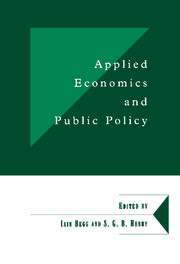Book contents
- Frontmatter
- Contents
- List of figures
- List of tables
- List of contributors
- Foreword
- 1 Introduction
- Part One MODELLING AND FORECASTING METHODS
- Part Two COMBINING DATA AND ANALYTIC TECHNIQUES
- Part Three USING MODELS TO GUIDE POLICY
- 10 On the equilibrium properties of macroeconomic models
- 11 Empirical analysis as an underpinning to policy
- 12 Using figures to guide macroeconomic policy
- Bibliography
- Index
12 - Using figures to guide macroeconomic policy
from Part Three - USING MODELS TO GUIDE POLICY
Published online by Cambridge University Press: 06 July 2010
- Frontmatter
- Contents
- List of figures
- List of tables
- List of contributors
- Foreword
- 1 Introduction
- Part One MODELLING AND FORECASTING METHODS
- Part Two COMBINING DATA AND ANALYTIC TECHNIQUES
- Part Three USING MODELS TO GUIDE POLICY
- 10 On the equilibrium properties of macroeconomic models
- 11 Empirical analysis as an underpinning to policy
- 12 Using figures to guide macroeconomic policy
- Bibliography
- Index
Summary
Context
Soon after Mrs Thatcher came to power, the Cambridge Economic Policy Group forecast that the policies of her government would cause the worst slump of the post-war period; simultaneously, Patrick Minford forecast that they would cause a boom. Angus Deaton (privately) made a ‘semi-serious’ forecast that, whatever else happened, we should all still be in business two years later.
Deaton's semi-joke raises profound questions. What framework of thought is appropriate for making judgements about macroeconomic policy and can it be rationalised, codified, and taught? How is work of this kind to be evaluated?
Before trying to answer these questions, let me describe what it is that I actually do and why.
Perspective
Any methodology for policy analysis obviously has to be conditional on a view about how the economy works and about what can be achieved by policy. My view is that fiscal and monetary policy can and should be used to keep aggregate demand growing fairly steadily at a level which is always well within the limits of the economy's productive potential; that net export demand as well as ‘capacity’ sets limits to the permissible growth rate, and therefore that domestic demand cannot be allowed to grow by more than is warranted by foreign trade performance. I do not rule out the use of incomes policy if inflation threatens.
Brass tacks
The macroeconomic conjuncture, with its attendant strategic problems, changes so drastically from period to period that it is difficult to say anything general about procedure: different circumstances call for different methods.
- Type
- Chapter
- Information
- Applied Economics and Public Policy , pp. 258 - 263Publisher: Cambridge University PressPrint publication year: 1998
- 3
- Cited by

